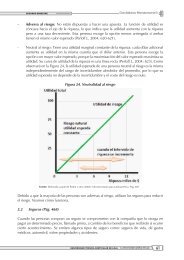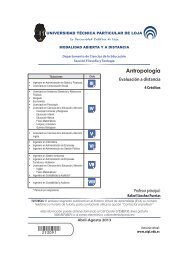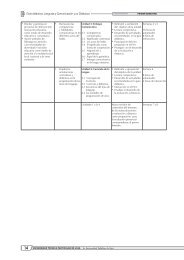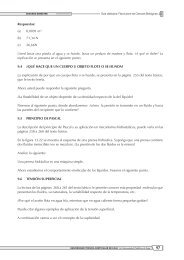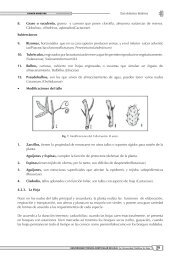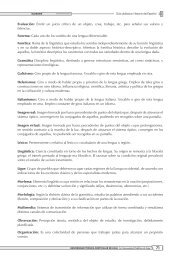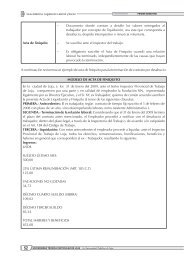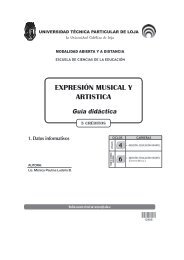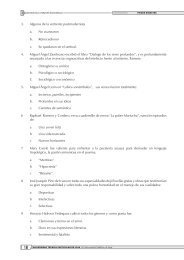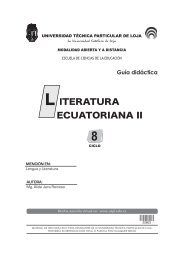CÁLCULO I - Universidad Técnica Particular de Loja
CÁLCULO I - Universidad Técnica Particular de Loja
CÁLCULO I - Universidad Técnica Particular de Loja
Create successful ePaper yourself
Turn your PDF publications into a flip-book with our unique Google optimized e-Paper software.
PRIMER BIMESTRE Guía didáctica: Cálculo I<br />
Clasificación y combinación <strong>de</strong> funciones<br />
Muy importante sino talvez el más importante, es el concepto <strong>de</strong> función compuesta para el <strong>de</strong>sarrollo<br />
<strong>de</strong>l Cálculo.<br />
El concepto <strong>de</strong> función compuesta <strong>de</strong>be estar claro ya que nos servirá <strong>de</strong> mucha ayuda para trabajar<br />
con funciones mucho más complejas, <strong>de</strong>rivar funciones más complejas, etc.<br />
En la página 24 una breve clasificación <strong>de</strong> las funciones elementales.<br />
Analicemos un ejemplo sobre funciones compuestas.<br />
Sea f(x) = x 2 − 1 . y g(x) = 4 / x . Hallar la composición <strong>de</strong>:<br />
a)<br />
b)<br />
a) <br />
f g(x)<br />
b) <br />
g f(x)<br />
f g(x) = f(g(x)) = f(4 / x) = (4 / x)2 − 1. Observe que el argumento <strong>de</strong> f(x) es la función g(x).<br />
f g(x) = (4 / x)<br />
<br />
2 − 1 =<br />
16 − x2<br />
. En este caso hemos resuelto la fracción<br />
x 2<br />
16 − x2<br />
f g(x) =<br />
<br />
x 2 , Por <strong>de</strong>finición x 2 = x , entonces sustituimos en el <strong>de</strong>nominador <strong>de</strong> la<br />
función, lo que nos da finalmente:<br />
<br />
f g(x) =<br />
16 − x 2<br />
x<br />
g f(x) = g(f(x)) =<br />
<br />
4<br />
x 2 . Observe que el argumento <strong>de</strong> g(x) lo constituye la función f(x).<br />
− 1<br />
F Como pue<strong>de</strong> observar, una función a su vez pue<strong>de</strong> ser argumento <strong>de</strong> otra función.<br />
Revise con <strong>de</strong>tenimiento los ejemplos <strong>de</strong> las páginas 25-26 los cuales le darán una i<strong>de</strong>a global<br />
y clara <strong>de</strong> la composición <strong>de</strong> funciones.<br />
IMPORTANTE:<br />
<br />
f g(x) ≠ g f(x)<br />
Revisemos algunos ejercicios adicionales<br />
1. Verifique si la función y = x es una función par.<br />
UNIVERSIDAD TÉCNICA PARTICULAR DE LOJA La <strong>Universidad</strong> Católica <strong>de</strong> <strong>Loja</strong> 21



